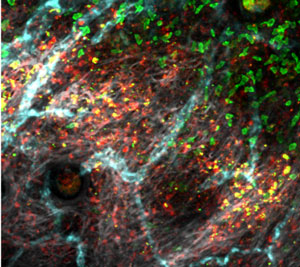T Cell Engineering for Cancer Immunotherapy
 Adoptive cell transfer utilizing genetically engineered cytotoxic T lymphocytes (CTLs) (e.g., chimeric antigen receptor (CAR)-T cells) is one of the most effective immunotherapies against hematological malignancies, but significant clinical success has not yet been achieved for solid tumors. Most solid tumors employ several strategies to attenuate immune-mediated killing by interfering with nearly every step required for effective immunity, including prevention of lymphocyte homing to the tumor sites and suppression of anti-tumor functions through strong immunosuppressive microenvironments. Although systemic or intratumoral delivery of an immune-boosting molecule to overcome local suppression has been proposed, but the full potential of this approach is limited by non-specific stimulation of tumor growth, metastasis, and angiogenesis. Furthermore, serious adverse events from immune-mediated reactions will likely increase in frequency and severity as immunotherapeutic approaches become more effective. Therefore, despite promising successes in the clinic, (1) impaired trafficking of CTLs to tumor sites, (2) strong immunosuppressive tumor microenvironment, and (3) off-target cytotoxicity are the main barriers to achieving the maximum benefit of adoptive T cell transfer immunotherapy. Our research aims to overcome these barriers in T cell immunotherapy using novel optogenetic approaches. Optogenetics combine “optics” and “genetics” to control defined cellular processes by controlling genetically modified light-sensitive proteins using optical stimulation. We hypothesize that optogenetic techniques will allow the remote control of T cell effector functions at tumor sites with outstanding specificity and temporospatial resolution. Our recently published studies highlight the development and application of optogenetic techniques to control T cell functions at tumor sites using light stimulation.
Adoptive cell transfer utilizing genetically engineered cytotoxic T lymphocytes (CTLs) (e.g., chimeric antigen receptor (CAR)-T cells) is one of the most effective immunotherapies against hematological malignancies, but significant clinical success has not yet been achieved for solid tumors. Most solid tumors employ several strategies to attenuate immune-mediated killing by interfering with nearly every step required for effective immunity, including prevention of lymphocyte homing to the tumor sites and suppression of anti-tumor functions through strong immunosuppressive microenvironments. Although systemic or intratumoral delivery of an immune-boosting molecule to overcome local suppression has been proposed, but the full potential of this approach is limited by non-specific stimulation of tumor growth, metastasis, and angiogenesis. Furthermore, serious adverse events from immune-mediated reactions will likely increase in frequency and severity as immunotherapeutic approaches become more effective. Therefore, despite promising successes in the clinic, (1) impaired trafficking of CTLs to tumor sites, (2) strong immunosuppressive tumor microenvironment, and (3) off-target cytotoxicity are the main barriers to achieving the maximum benefit of adoptive T cell transfer immunotherapy. Our research aims to overcome these barriers in T cell immunotherapy using novel optogenetic approaches. Optogenetics combine “optics” and “genetics” to control defined cellular processes by controlling genetically modified light-sensitive proteins using optical stimulation. We hypothesize that optogenetic techniques will allow the remote control of T cell effector functions at tumor sites with outstanding specificity and temporospatial resolution. Our recently published studies highlight the development and application of optogenetic techniques to control T cell functions at tumor sites using light stimulation.